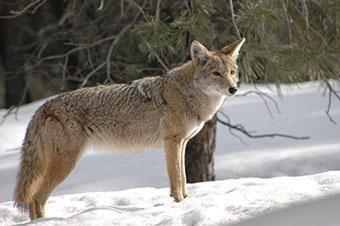
Winter’s Not Always a Sleepy Time for Our Furry Friends

While cold and snowy conditions force humans indoors seeking warmth and safety, many animals outside are mating, nesting and giving birth amid ice, snow storms and freezing temperatures.
While some animals — bears, for instance — go into hibernation and sleep away the winter months, most animals go into a semi-hibernating state and can become active on warm days. White-tailed deer mate by November but remain active all year. Bats and bears have already mated by the time they go into hibernation. Bear cubs are born in January, and bat pups in May or June. Deer can birth up to three fawns from April through early July.
Owls call and claim nesting territory in December and sit on their nests while we are celebrating Christmas, Hanukkah and New Year’s. I’ve seen great horned owls covered with inches of snow while tending their nests and keeping their eggs warm. Eagles rebuild their nests during winter and are sitting on eggs by the end of February. Owlets (great horned, screech and saw whets) are usually the first to arrive at wildlife rehab centers, followed by grey squirrels.
Coyotes mate January through March, so some could be birthing their young by March if they mated in January. Coyotes, by the way, reside in every county in Pennsylvania, including Philadelphia. They are shy animals and do not attack humans or children. They can kill cats and small dogs, but with the abundance of trash in Philadelphia, they spend much of their time raiding our garbage, much like raccoons. Coyotes are amazingly resilient, having been persecuted their entire lives; there is still open hunting season on coyotes every day of the year in Pennsylvania. Foxes mate in January and are usually born in March. Both coyote pups and fox kits will stay in their dens until spring.
Among local birds, pigeons and house sparrows mate in January and are our earliest breeders. Woodpeckers follow in mid-March, along with chickadees, tufted titmice and northern cardinals. Woodpeckers often use the aluminum downspouts found on our houses to establish their territory.
Climate and light influence birthing and breeding cycles. Domestic cats, like many wild animals, used to stop having kittens in the fall when days became shorter and darker. Now, with so much artificial lighting around shopping malls, highways and even residential neighborhoods, cats can go into estrus all year long, and kittens are being born outside in deadly conditions.
In the spring, you might see a nocturnal animal out during the day. If it is acting appropriately (i.e., running away from humans), it often is a female foraging for food for her screaming, hungry offspring. Females need increased calories themselves when they are nursing, and if they aren’t successful hunting/foraging during the night, they are pressed to hunt in daylight hours. Often too, nocturnal animals are disturbed by dogs, humans and construction crews and are forced to flee their home base. So as long as a nocturnal animal is running away from humans and not circling, falling or foaming, there is no need to panic.
When we have days with 70-degree temperatures in winter, even hibernating animals awaken in a confused state. Bats often wake up thirsty and dehydrated and may be seen flying outdoors or even inside homes, looking for a quick drink. Please do not put a bat outside in the winter, when there are no bugs to be found. Bats also cannot fly for any length of time in cold conditions. A bat that awakens and becomes active during the winter needs to be overwintered at a licensed wildlife rehab facility that can accept rabies vector species — Philadelphia Metro Wildlife Center in King of Prussia, for example.
Animals can use a hand from us to get through the winter. Consider putting a shelter in your yard filled with straw, not fabric, which retains moisture and will freeze. Straw is an excellent insulator and allows animals to burrow into it. Heated bowls or heating elements in birdbaths can be lifesavers for dehydrated animals when all water sources are frozen.
Wild animals would prefer to not live in such close proximity to humans, but they don’t have a choice. They need us humans to be tolerant and compassionate of their circumstances. The skunk or groundhog under your shed is simply trying to survive.
Brenda Malinics is a wildlife rehabber and cat rescuer. Reach her at brendasrescues@gmail.com.
